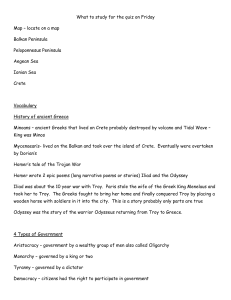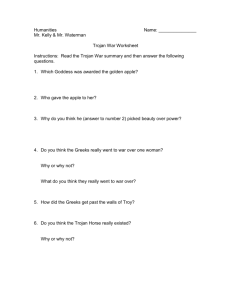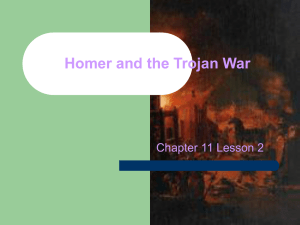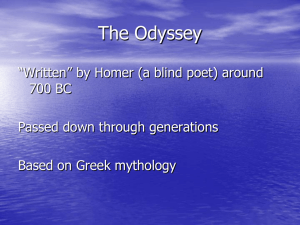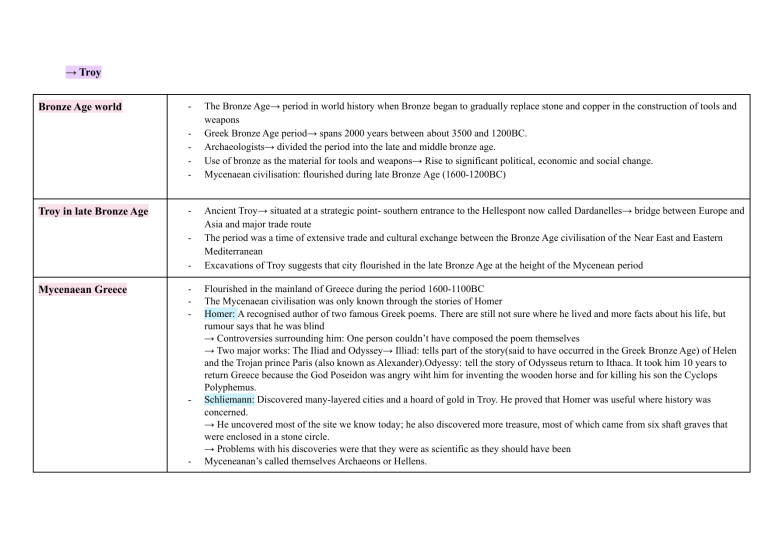
→ Troy Bronze Age world - Troy in late Bronze Age - Mycenaean Greece - - - The Bronze Age→ period in world history when Bronze began to gradually replace stone and copper in the construction of tools and weapons Greek Bronze Age period→ spans 2000 years between about 3500 and 1200BC. Archaeologists→ divided the period into the late and middle bronze age. Use of bronze as the material for tools and weapons→ Rise to significant political, economic and social change. Mycenaean civilisation: flourished during late Bronze Age (1600-1200BC) Ancient Troy→ situated at a strategic point- southern entrance to the Hellespont now called Dardanelles→ bridge between Europe and Asia and major trade route The period was a time of extensive trade and cultural exchange between the Bronze Age civilisation of the Near East and Eastern Mediterranean Excavations of Troy suggests that city flourished in the late Bronze Age at the height of the Mycenean period Flourished in the mainland of Greece during the period 1600-1100BC The Mycenaean civilisation was only known through the stories of Homer Homer: A recognised author of two famous Greek poems. There are still not sure where he lived and more facts about his life, but rumour says that he was blind → Controversies surrounding him: One person couldn’t have composed the poem themselves → Two major works: The Iliad and Odyssey→ Illiad: tells part of the story(said to have occurred in the Greek Bronze Age) of Helen and the Trojan prince Paris (also known as Alexander).Odyessy: tell the story of Odysseus return to Ithaca. It took him 10 years to return Greece because the God Poseidon was angry wiht him for inventing the wooden horse and for killing his son the Cyclops Polyphemus. Schliemann: Discovered many-layered cities and a hoard of gold in Troy. He proved that Homer was useful where history was concerned. → He uncovered most of the site we know today; he also discovered more treasure, most of which came from six shaft graves that were enclosed in a stone circle. → Problems with his discoveries were that they were as scientific as they should have been Myceneanan’s called themselves Archaeons or Hellens. General information Discovery and excavation of Troy - Modern-day country Troy was located in→ Turkey. - Life in Ancient Greece → Greek cities had beautiful temples, statues, open theatres → People mostly lived in villages or the countryside - Troy has been kept alive in myths, legends and literature, but the location remained unknown until modern times 24 excavation camps have been conducted at a site in modern-day Turkey, Hissark(the modern-day name for Troy) over last 140 years → These excavations showed that several cities had been built over and above each other, creating a mound or ‘tell’ of Hissarlik Importance of the multidisciplinary approach Since excavation began in 1869s, various archeologists have contributed to the rediscovery of Troy, the interpretation of evidence and our understanding of the period The major focus of the work of archeologists has been the attempt to identity from the start the one that they believe is the Troy of the period of the Trojan War→ in late bronze age 1200BC - The role and status of women: treatment of Helen of Trojan and greek women, goddesses - - Questions Women are significant in Homer's Iliad. According to Iliad, the abduction of Helen and the relationship between Paris and Helen caused the Trojan war A lot of stories in Iliad about Trojan women such as → Hebuca (hector and Paris mother) → Andromache (Hector’s wife) Women were expected to marry and produce children→ marriages provided alliances between powerful families Hughes: According to him Helen was a demi-god, a heroine worshipped at shrines. That she was an idol female of beauty and sexuality; both lusted after and deposed. A queen also who welcomed a Trojan prince in her bed while her husband was overseas In the period when Homer Iliad is set: (role and status of women) → Women were viewed symbolically and literally as properties-prizes of contests and spoils of war → Also, womens domination over them increased the male’s prestige → They were seen as the property of males → Which historical age is the Trojan War thought to have occurred? Bronze Age (approx 2300 years between about 3500 and 1200 BC) - Late Bronze Age (c. 1600 -1200 BC) → What did people in this period start to do? Learnt how to mine and smelt copper and tin to make bronze weapons and tools → What is our main written source for the mythological stories of the Trojan War? Homer’s Iliad → What is an epic poem? A long poem, usually from ancient oral tradition, narrates the deeds and adventures of heroic figures → Where was Ancient Troy situated? (think - strategic point) The southern entrance to the Hellespont (now called the Dardanelles), a narrow passage of water linking the Black Sea with the Aegean Sea via the Sea of Marmara - it was a bridge between Europe and Asia and was a significant trade route. This was a time of extensive trade and cultural exchange between the Bronze Age civilisations of the Near East and the eastern Mediterranean → Which modern-day country is Troy located in? Turkey → Who were the king and queen of Troy? Priam and Hecuba → What were the names of their two sons? Hector and Paris → Who was Helen of Sparta married to? What was his brother’s name? Hector and Paris → What do we know about Homer? Very little is known about him, tradition has it that he was born in Asia Minor in the 8th century BC and that he was blind. Author of Iliad and Odyssey. Ancient epic of the Trojan War attributed to Homer is based on an oral tradition in which a number of stories are woven together to form a long narrative (epic cycle) → When did excavations begin at Troy? The 1860s → How many excavation campaigns have been conducted at Troy? 24 → List in chronological order, the archaeologists who excavated at Troy. Frank Calvert, Heinrich Schliemann, Wilhelm Dorpfeld, Carl Blegen, Manfred Korfmann → Which archaeologist discovered the ‘Treasure of Priam’? Heinrich Schliemann → What are the layers exposed during an excavation called? Strata - these are tagged with labels to differentiate them from each other (eg. levels of Troy) Source: Movie ‘Troy” - → Teotihuacan Questions → Where is Teotihuacan located? In the Mexico Valley - about 50 km NE of Mexico City → Describe the geography of the area. Relatively flat, partially enclosed, surrounded by mountains and volcanoes. Covered with lava and lava mounds which weathered into fertile soil → What are some of the reasons given by scholars as to why the unknown founders of Teotihuacan may have chosen the site for their city? Presence of a natural lava tube cave - caves are a key part of symbolic imagery associated with creation myths and the underworld, San Juan River provided a source of water for agriculture (most of the pop were farmers), a good trade route, a rich source of highly prized black volcanic glass (obsidian) → What did the Teotihuacanos build within its natural landscape? Magnificent sacred and urban complex, great stone monuments → For how long was Teotihuacan in ruins before the Aztecs settled in Mexico Valley? Had been in ruins for more than 500 years → What are some of the greatest problems facing historians about Teotihuacan? No knowledge of the spoken language, no written histories or textual writing system that is obvious at this point → Which temple is Dr Sergio Gomez known to have excavated? Temple of the Feathered Serpent → Who initiated the Teotihuacan Mapping Project? Archaeologist Rene Millon → Name the 3 main pyramids. Three main pyramids - Temple of the Moon, Pyramid of the Sun, Pyramid of the Feathered Serpent → Approximately how many apartment complexes have been excavated? Approximately 2000 apartment complexes have been excavated → What was the purpose of patio platforms? Served as a local temple for rituals and ceremonies. → What are some of the artefacts that have been found in all socioeconomic compounds? Stone bowls, mass-produced ceramic or stone incense burners, figurines. → What do some experts believe is the significance of so many funerary masks? Might indicate some association with a funerary cult. → Outline the triad of possible deities and chief deities in Teotihuacan.The possible triad of astral deities - Sun, Moon and Venus. Chief deities - Great Goddess, Feathered Serpent, Storm/Rain God (Tlaloc) → When did the Teotihuacanos practise human sacrifice? How were the sacrifices killed? When a building was being constructed or dedicated, maybe during times of crisis, to help the city prosper. Killed in a variety of ways - buried alive, decapitated, having hearts removed. Sacrifices were most probably enemy warriors who had been captured after the battle. → What did Rene Millon suggest about the nature of rulership in Teotihuacan? A debatable topic. Millon suggests that a supreme political power may not have always been a single person or lineage, but may have been an oligarchy. → Define oligarchy. Oligarchy - A government or small group of powerful people. → What are chinampas? system of raised, flooded fields which would later be used so effectively by the Aztecs → List some examples of the crops cultivated in Teotihuacan.Crops such as corn, beans, squash, tomato, amaranth, avocado, cactus and chilli peppers. → What are the three theories about the collapse of Teotihuacan? Natural disaster, internal rebellion, external attack M, cartwright,Teotihuacan - Largest.most influential and certainly most revealed city in the history of the New world Its architecture, art and religion-would influence all subsequent Mesoamerican Cultures(eg Aztecs) Mesoamerica - Name for areas of Mexico and Central America Were civilized before the Spanish arrived Aztecs - They had human sacrifice in their rituals They ate corn or maze They praised different gods but had one significant God Men/boys usually joined the army/warriors They had temples and priests-RELIGIOUS They had an emperor They often fought a lot Had a larger civilization until wipes out from disease Had a Hierachy-Peasants, farmers Had a form of schooling - Rip out hearts of the sacrifices TEOTIHUACAN IS THE CIVILISATION, BEFORE THE AZTECS IN CENTRAL MEXICO → Role and impact of women in ancient Greece and Rome The chronological and geographical context of the society within the Ancient world Introduction to Ancient Greece - Aegean sea- about 4000 years ago - a vast empire - Heroes, art, philosophy, democracy - Just a few of their achievements - 1500 territories (eg Sparta) - acted as sovereign nations(supreme ruler, esp a monarch) - First large scale democracy - Athens- gave Greek people representation and political power - Empire - Political, militaristic, cultural achievements - Military - Strong reputation, helped expand the empire, man Greeks took great pride in their military-soldiers seen as heroes - Cultural contributions, art and architecture - Columns, Parthenon-irritated by other civilisations Greek religion helped shaped the Ancient Rome religion Greek philosophy (law and ethics) also influenced other civilisations The Greek language provided the basis of many modern languages Introduction to Ancient Rome - Ancient Rome divided into THREE MAJOR PERIODS : 1) Regal → 753B.C -510 B.C 2) Republican → 509 B.C - 29 B.C 3) Imperial → 27B.C-A.D 476 - Began as a small village on the Tiber River (grew into an empire) - Pride in military - Conquered neighbouring people (eg Greek, Egyptians etc) - Advancements in engineering (aqueducts, bathhouse etc) - Communication with different people - the inclusion of cultures from lands they conquered - Heavily influenced by the Greeks (seen in art and architecture) - Emperors - Octavian /Augustus(peace),Nero(cruel) - Rise of Christianity The role and impact of women -The range of sources available for women and gaps in the evidence -Pg 358-359 Social status of women - Pg360 The impact and representation of influential women
